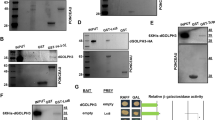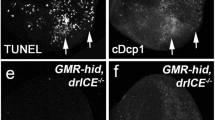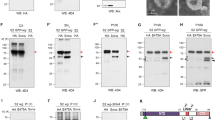Abstract
THE X-linked prune (pn) eye-colour mutation of Drosophila melanogaster has a highly specific, complementary lethal interaction with the conditional dominant Killer of prune (awdK-pn) mutation1,2. Although awdK-pn flies have no apparent phenotype on their own, pn awdK-pn double mutants die as second or third larval instars. The awd locus encodes a nucleoside diphosphate kinase3, an enzyme that catalyses the transfer of high-energy phosphate bonds between nucleoside diphosphates and nucleoside triphosphates4, which is essential for the normal development of Drosophila. Analysis of the pn locus has suggested that the complementary DNA, TcD37, encodes a putative pn+ product5. Here we report the nucleotide sequence of TcD37 and the similarity of its deduced protein product to the catalytic domain of mammalian GTPase-activating proteins (GAPs); GAPs stimulate the GTPase activity of Ras (ref. 6), which are plasma membrane-bound proteins involved in the regulation of cell proliferation and differentiation7. These results suggest that the Drosophila TcD37 protein participates in a biochemical pathway similar to that of Ras and GAPs in mammals and yeast. We propose that the interaction between pn and awd is due to a neomorphic mutation that enhances the ability of AwdK-pn nucleoside diphosphate kinase to induce a regulatory GTPase into a GTP-bound 'on' state, whereas Pn modulates the activity of this GTPase either by switching it to a GDP-bound 'off' state or by interfering with its effector function.
This is a preview of subscription content, access via your institution
Access options
Subscribe to this journal
Receive 51 print issues and online access
$199.00 per year
only $3.90 per issue
Buy this article
- Purchase on Springer Link
- Instant access to full article PDF
Prices may be subject to local taxes which are calculated during checkout
Similar content being viewed by others
References
Sturtevant, A. H. Genetics 41, 118–123 (1956).
Biggs, J., Tripoulas, N., Hesperger, E., Dearolf, C. & Shearn, A. Genes Dev. 2, 1333–1343 (1988).
Biggs, J., Hesperger, E., Steeg, P. S., Liotta, L. A. & Shearn, A. Cell 63, 933–940 (1990).
Parks, R. E. J. & Agarwal, R. P. in The Enzymes (ed. Boyer, P. D.) 307–344 (Academic, New York, 1973).
Teng, D. H. F., Bender, L. B., Engele, C. M., Tsubota, S. & Venkatesh, T. Genetics 128, 373–380 (1991).
Vogel, U. S. et al. Nature 335, 90–93 (1988).
Bourne, H. R., Sanders, D. A. & McCormick, F. Nature 348, 125–132 (1990).
Evans, B. A. & Howells, A. J. Biochem. Genet. 16, 13–26 (1978).
Mackay, W. J. & O'Donnell, J. M. Genetics 105, 35–53 (1983).
Brown, G. M. Chemistry and Biochemistry of Pterins (eds Blakley, R. L. & Benkovic, S. J.) 115–154 (Wiley, New York, 1985).
MacLean, J. R., Boswell, R. & O'Donnell, J. Genetics 126, 1007–1019 (1990).
Dearolf, C. R., Hesperger, E. & Shearn, A. Devl. Biol. 129, 159–168 (1988).
Wallet, V. et al. J. natn. Cancer Inst. 82, 1199–1202 (1990).
Kozak, M. Nucleic Acids Res. 12, 857–872 (1984).
Marshall, M. S. et al. EMBO J. 8, 1105–1110 (1989).
Trahey, M. et al. Science 242, 1697–1700 (1988).
Xu, G. et al. Cell 62, 599–608 (1990).
Xu, G. et al. Cell 63, 835–841 (1990).
Martin, G. A. et al. Cell 63, 843–849 (1990).
Ballester, R. et al. Cell 63, 851–859 (1990).
Tanaka, K. et al. Cell 60, 803–807 (1990).
Tanaka, K., Lin, B. K., Wood, D. R. & Tamanoi, F. Proc. natn. Acad. Sci. U.S.A. 88, 468–472 (1991).
Colicelli, J. et al. Proc. natn. Acad. Sci. U.S.A. 88, 2913–2917 (1991).
Rubinfeld, B. et al. Cell 65, 1033–1042 (1991).
Bourne, H. R., Sanders, D. A. & McCormick, F. Nature 349, 117–126 (1991).
Garrett, M. D., Self, A. J., van Oers, C. & Hall, A. J. J. biol. Chem. 264, 10–13 (1989).
Burstein, E. S., Linko-Stentz, K., Lu, Z. & Macara, I. G. J. biol. Chem. 266, 2689–2692 (1991).
Emkey, R., Freedman, S. & Feig, L. A. J. biol. Chem. 266, 9703–9706 (1991).
Liotta, L. A. & Steeg, P. S. J. natn. Cancer Inst. 82, 1170–1172 (1990).
Liotta, L. A., Steeg, P. S. & Stetler-Stevenson, W. G. Cell 64, 327–336 (1991).
Henikoff, S. Meth. Enzym. 155, 156–165 (1987).
Sanger, F., Nicklen, S. & Coulson, A. R. Proc. natn. Acad. Sci. U.S.A. 74, 546–5467 (1977).
Hultmark, D., Klemenz, R. & Gehring, W. Cell 44, 429–438 (1986).
O'Hare, K. & Rubin, G. M. Cell 34, 25–35 (1983).
Kyte, J. & Doolittle, R. F. J. molec. Biol. 157, 105–132 (1982).
Author information
Authors and Affiliations
Rights and permissions
About this article
Cite this article
Teng, D., Engele, C. & Venkatesh, T. A product of the prune locus of Drosophila is similar to mammalian GTPase-activating protein. Nature 353, 437–440 (1991). https://doi.org/10.1038/353437a0
Received:
Accepted:
Issue Date:
DOI: https://doi.org/10.1038/353437a0
This article is cited by
-
A competitive cell-permeable peptide impairs Nme-1 (NDPK-A) and Prune-1 interaction: therapeutic applications in cancer
Laboratory Investigation (2018)
-
Developmental function of Nm23/awd: a mediator of endocytosis
Molecular and Cellular Biochemistry (2009)
-
NM23 as a prognostic biomarker in ovarian serous carcinoma
Modern Pathology (2008)
-
Evidence for interaction between human PRUNE and nm23-H1 NDPKinase
Oncogene (1999)
-
Immunohistochemical expression of nm23 gene product, nucleotide diphosphate kinase, in pancreatic neoplasms
International Journal of Gastrointestinal Cancer (1997)
Comments
By submitting a comment you agree to abide by our Terms and Community Guidelines. If you find something abusive or that does not comply with our terms or guidelines please flag it as inappropriate.



